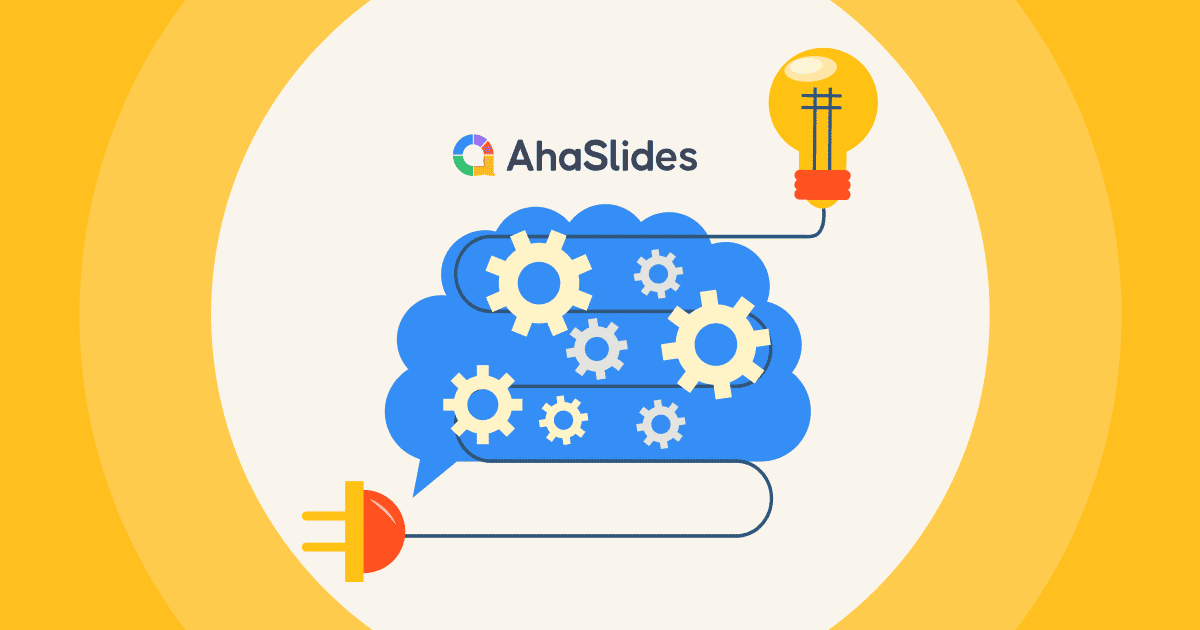![]() Formative assessment activities are considered one of the essential elements of education because of their motivation for learners and their immediate effects on the learning-teaching process. These activities help instructors receive feedback to self-understand limitations, as well as current skills, to develop the next steps in the classroom.
Formative assessment activities are considered one of the essential elements of education because of their motivation for learners and their immediate effects on the learning-teaching process. These activities help instructors receive feedback to self-understand limitations, as well as current skills, to develop the next steps in the classroom.
![]() In this post, I'm sharing seven formative assessment activities that have transformed my classroom and those of educators I work with. These aren't theoretical concepts from a textbook—they're battle-tested strategies that have helped thousands of students feel seen, understood, and empowered in their learning journey.
In this post, I'm sharing seven formative assessment activities that have transformed my classroom and those of educators I work with. These aren't theoretical concepts from a textbook—they're battle-tested strategies that have helped thousands of students feel seen, understood, and empowered in their learning journey.
 차례
차례
 What Makes Formative Assessment Essential in 2025?
What Makes Formative Assessment Essential in 2025?
![]() Formative assessment is the ongoing process of gathering evidence about student learning during instruction to make immediate adjustments that improve both teaching and learning outcomes.
Formative assessment is the ongoing process of gathering evidence about student learning during instruction to make immediate adjustments that improve both teaching and learning outcomes.![]() According to the Council of Chief State School Officers (CCSSO), formative assessment is "a planned, ongoing process used by all students and teachers during learning and teaching to elicit and use evidence of student learning to improve student understanding of intended disciplinary learning outcomes and support students to become self-directed learners." Unlike summative assessments that evaluate learning after instruction is complete, formative assessments happen in the moment, allowing teachers to pivot, reteach, or accelerate based on real-time data.
According to the Council of Chief State School Officers (CCSSO), formative assessment is "a planned, ongoing process used by all students and teachers during learning and teaching to elicit and use evidence of student learning to improve student understanding of intended disciplinary learning outcomes and support students to become self-directed learners." Unlike summative assessments that evaluate learning after instruction is complete, formative assessments happen in the moment, allowing teachers to pivot, reteach, or accelerate based on real-time data.
![]() The landscape of education has shifted dramatically since I first stepped into a classroom in 2015. We've navigated remote learning, embraced new technologies, and redefined what engagement looks like in our post-pandemic world. Yet the fundamental need to understand our students' learning journey remains unchanged—if anything, it's become more crucial than ever.
The landscape of education has shifted dramatically since I first stepped into a classroom in 2015. We've navigated remote learning, embraced new technologies, and redefined what engagement looks like in our post-pandemic world. Yet the fundamental need to understand our students' learning journey remains unchanged—if anything, it's become more crucial than ever.

 The Research Behind Formative Assessment
The Research Behind Formative Assessment
![]() The foundational research on formative assessment, beginning with Black and Wiliam's influential 1998 review of over 250 studies, consistently demonstrates significant positive effects on student achievement. Their research found effect sizes ranging from 0.4 to 0.7 standard deviations—equivalent to advancing students' learning by 12-18 months. More recent meta-analyses, including Hattie's review of 12 meta-analyses on feedback in classrooms, concluded that under the right conditions, feedback in a formative context can contribute significantly to students' achievement, with an average effect size of 0.73.
The foundational research on formative assessment, beginning with Black and Wiliam's influential 1998 review of over 250 studies, consistently demonstrates significant positive effects on student achievement. Their research found effect sizes ranging from 0.4 to 0.7 standard deviations—equivalent to advancing students' learning by 12-18 months. More recent meta-analyses, including Hattie's review of 12 meta-analyses on feedback in classrooms, concluded that under the right conditions, feedback in a formative context can contribute significantly to students' achievement, with an average effect size of 0.73.
![]() The Organisation for Economic Cooperation and Development (OECD) has identified formative assessment as "one of the most effective strategies for promoting high performance in schools," noting that achievement gains attributed to formative assessment are "quite high". However, the OECD also notes that despite these benefits, formative assessment "is not yet practiced systematically" in most educational systems.
The Organisation for Economic Cooperation and Development (OECD) has identified formative assessment as "one of the most effective strategies for promoting high performance in schools," noting that achievement gains attributed to formative assessment are "quite high". However, the OECD also notes that despite these benefits, formative assessment "is not yet practiced systematically" in most educational systems.
![]() The key lies in creating a feedback loop where:
The key lies in creating a feedback loop where:
 Students receive immediate, specific feedback
Students receive immediate, specific feedback about their understanding
about their understanding  Teachers adjust instruction
Teachers adjust instruction based on evidence of student learning
based on evidence of student learning  Learning becomes visible
Learning becomes visible to both teachers and students
to both teachers and students  Students develop metacognitive skills
Students develop metacognitive skills and become self-directed learners
and become self-directed learners
 7 High-Impact Formative Assessment Activities That Transform Learning
7 High-Impact Formative Assessment Activities That Transform Learning
 1. Quick Formative Quizzes
1. Quick Formative Quizzes
![]() Forget pop quizzes that induce panic. Quick formative quizzes (3-5 questions, 5-7 minutes) serve as learning diagnostics that inform your next instructional moves.
Forget pop quizzes that induce panic. Quick formative quizzes (3-5 questions, 5-7 minutes) serve as learning diagnostics that inform your next instructional moves.
![]() 설계 원칙:
설계 원칙:
 Focus on one key concept
Focus on one key concept per quiz
per quiz  Include a mix of question types:
Include a mix of question types: multiple choice, short answer, and application
multiple choice, short answer, and application  Make them low-stakes:
Make them low-stakes: worth minimal points or ungraded
worth minimal points or ungraded  Provide immediate feedback
Provide immediate feedback through answer discussions
through answer discussions
![]() Smart quiz questions:
Smart quiz questions:
 "Explain this concept to a 5th grader"
"Explain this concept to a 5th grader" "What would happen if we changed this variable?"
"What would happen if we changed this variable?" "Connect today's learning to something we studied last week"
"Connect today's learning to something we studied last week" "What's still confusing about this topic?"
"What's still confusing about this topic?"
![]() Digital tools that work:
Digital tools that work:
 Kahoot for gamified engagement
Kahoot for gamified engagement AhaSlides for self-paced and real-time results
AhaSlides for self-paced and real-time results Google Forms for detailed feedback
Google Forms for detailed feedback
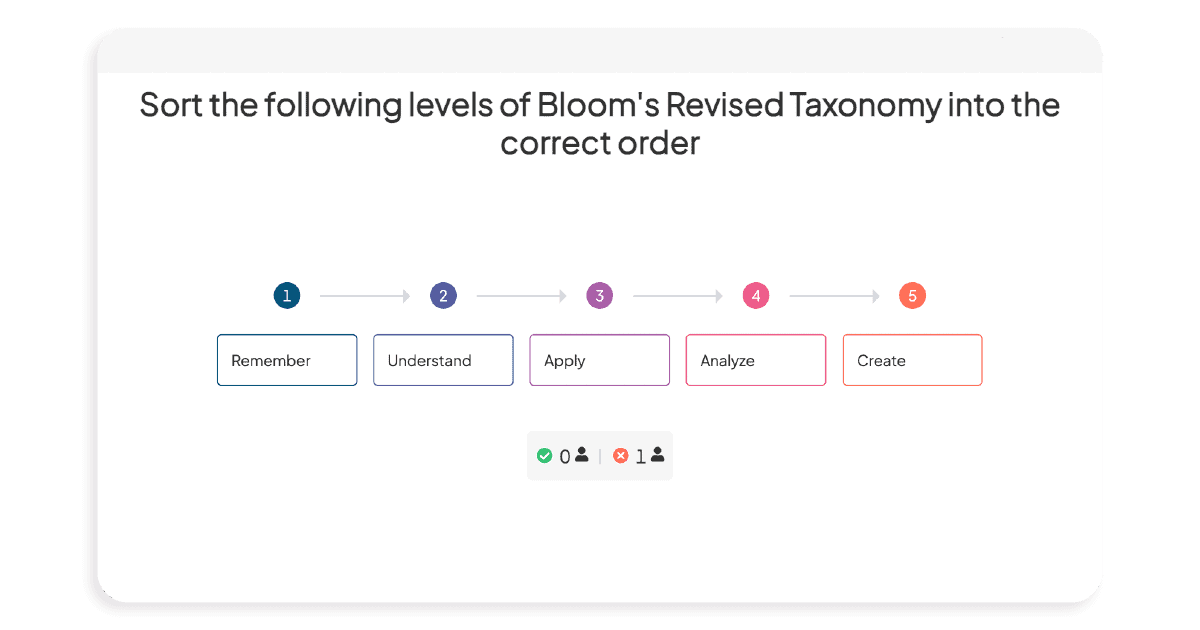
 2. Strategic Exit Tickets: The 3-2-1 Power Play
2. Strategic Exit Tickets: The 3-2-1 Power Play
![]() Exit tickets aren't just end-of-class housekeeping—they're goldmines of learning data when designed strategically. My favorite format is the
Exit tickets aren't just end-of-class housekeeping—they're goldmines of learning data when designed strategically. My favorite format is the ![]() 3-2-1 reflection:
3-2-1 reflection:
 3 things you learned today
3 things you learned today 2 questions you still have
2 questions you still have 1 way you'll apply this knowledge
1 way you'll apply this knowledge
![]() Pro implementationtTips:
Pro implementationtTips:
 Use digital tools like Google Forms or Padlet for instant data collection
Use digital tools like Google Forms or Padlet for instant data collection Create differentiated exit tickets based on learning objectives
Create differentiated exit tickets based on learning objectives Sort responses into three piles: "Got it," "Getting there," and "Need support"
Sort responses into three piles: "Got it," "Getting there," and "Need support" Use the data to plan your next day's opening activities
Use the data to plan your next day's opening activities
![]() Real classroom example:
Real classroom example:![]() After teaching photosynthesis, I used exit tickets to discover that 60% of students still confused chloroplasts with mitochondria. The next day, I started with a quick visual comparison activity instead of moving to cellular respiration as planned.
After teaching photosynthesis, I used exit tickets to discover that 60% of students still confused chloroplasts with mitochondria. The next day, I started with a quick visual comparison activity instead of moving to cellular respiration as planned.
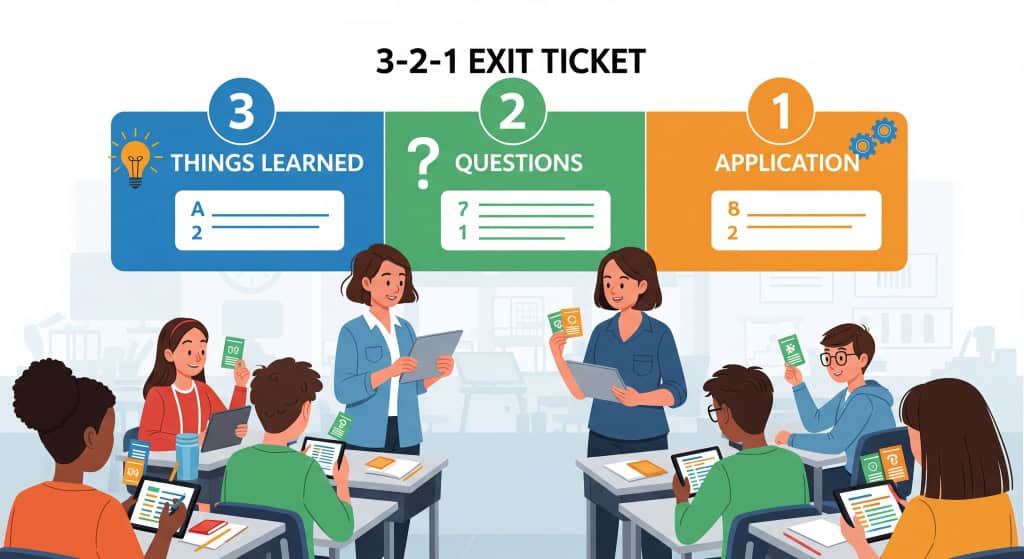
 3. Interactive Polling
3. Interactive Polling
![]() Interactive polling transforms passive listeners into active participants while giving you real-time insights into student understanding. But the magic isn't in the tool—it's in the questions you ask.
Interactive polling transforms passive listeners into active participants while giving you real-time insights into student understanding. But the magic isn't in the tool—it's in the questions you ask.
![]() High-impact poll questions:
High-impact poll questions:
 개념적 이해:
개념적 이해: "Which of these best explains why..."
"Which of these best explains why..."  어플리케이션:
어플리케이션: "If you were to apply this concept to solve..."
"If you were to apply this concept to solve..."  Metacognitive:
Metacognitive: "How confident are you in your ability to..."
"How confident are you in your ability to..."  Misconception checks:
Misconception checks: "What would happen if..."
"What would happen if..."
![]() 구현 전략:
구현 전략:
 Use tools like AhaSlides for easy interactive polling
Use tools like AhaSlides for easy interactive polling Ask 2-3 strategic questions per lesson, not just fun trivia
Ask 2-3 strategic questions per lesson, not just fun trivia Display results to spark class discussions about reasoning
Display results to spark class discussions about reasoning Follow up with "Why did you choose that answer?" conversations
Follow up with "Why did you choose that answer?" conversations
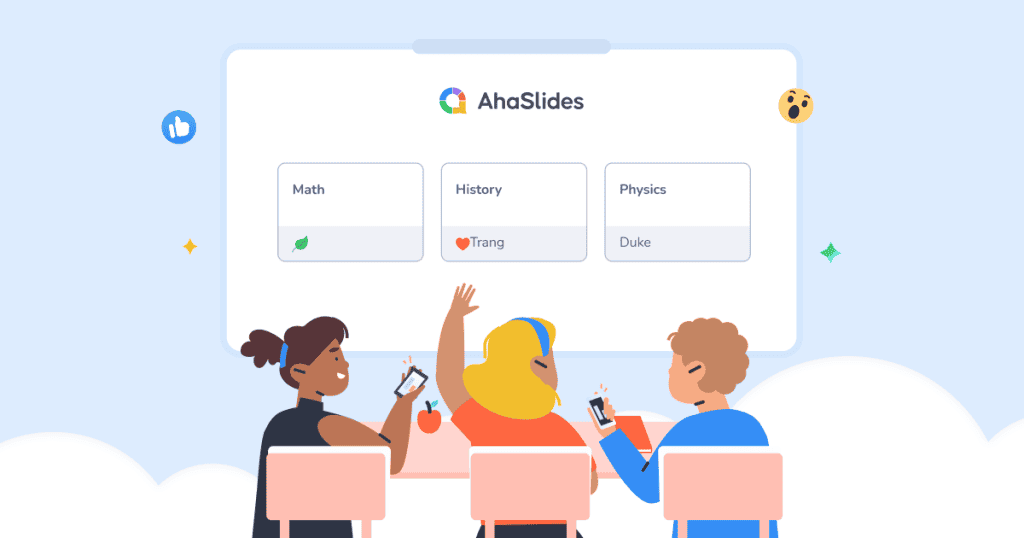
 4. Think-Pair-Share 2.0
4. Think-Pair-Share 2.0
![]() The classic think-pair-share gets a modern upgrade with structured accountability. Here's how to maximize its formative assessment potential:
The classic think-pair-share gets a modern upgrade with structured accountability. Here's how to maximize its formative assessment potential:
![]() Enhanced process:
Enhanced process:
 Think (2 minutes):
Think (2 minutes): Students write their initial thoughts
Students write their initial thoughts  Pair (3 minutes):
Pair (3 minutes): Partners share and build on ideas
Partners share and build on ideas  Share (5 minutes):
Share (5 minutes): Pairs present refined thinking to the class
Pairs present refined thinking to the class  Reflect (1 minute):
Reflect (1 minute): Individual reflection on how thinking evolved
Individual reflection on how thinking evolved
![]() 평가:
평가:
 Watch for students who rely heavily on partners versus contributing equally
Watch for students who rely heavily on partners versus contributing equally Circulate during pair discussions to eavesdrop on misconceptions
Circulate during pair discussions to eavesdrop on misconceptions Use a simple tracking sheet to note which students struggle to articulate ideas
Use a simple tracking sheet to note which students struggle to articulate ideas Listen for vocabulary usage and conceptual connections
Listen for vocabulary usage and conceptual connections
 5. Learning Galleries
5. Learning Galleries
![]() Transform your classroom walls into galleries of learning where students display their thinking visually. This activity works across all subject areas and provides rich assessment data.
Transform your classroom walls into galleries of learning where students display their thinking visually. This activity works across all subject areas and provides rich assessment data.
![]() Gallery formats:
Gallery formats:
 Concept maps:
Concept maps: Students create visual representations of how ideas connect
Students create visual representations of how ideas connect  Problem-solving journeys:
Problem-solving journeys: Step-by-step documentation of thinking processes
Step-by-step documentation of thinking processes  Prediction galleries:
Prediction galleries: Students post predictions, then revisit after learning
Students post predictions, then revisit after learning  Reflection boards:
Reflection boards: Visual responses to prompts using drawings, words, or both
Visual responses to prompts using drawings, words, or both
![]() Assessment strategy:
Assessment strategy:
 Use gallery walks for peer feedback using specific protocols
Use gallery walks for peer feedback using specific protocols Take photos of student work for digital portfolios
Take photos of student work for digital portfolios Note patterns in misconceptions across multiple student artifacts
Note patterns in misconceptions across multiple student artifacts Have students explain their thinking during gallery presentations
Have students explain their thinking during gallery presentations
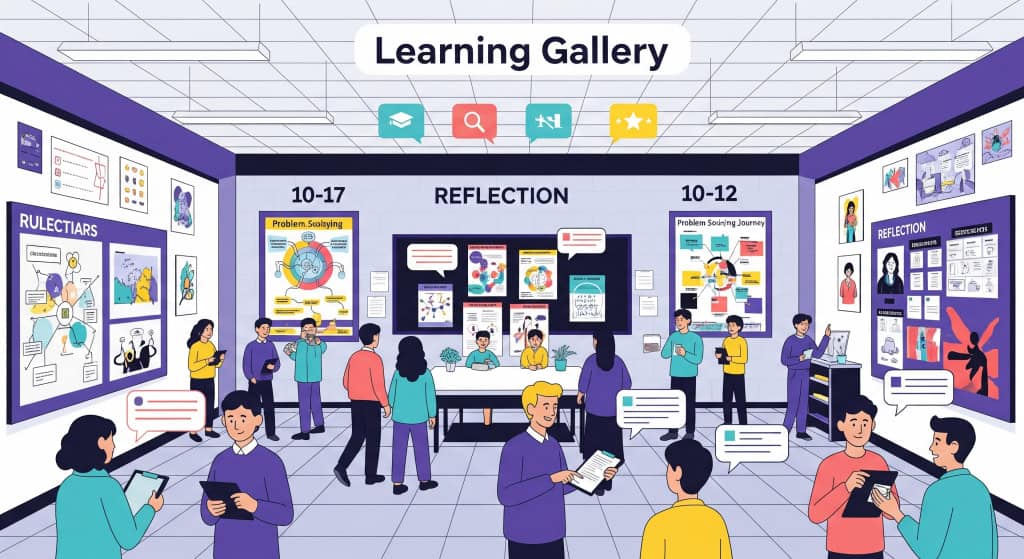
 6. Collaborative Discussion Protocols
6. Collaborative Discussion Protocols
![]() Meaningful classroom discussions don't happen by accident—they require intentional structures that make student thinking visible while maintaining engagement.
Meaningful classroom discussions don't happen by accident—they require intentional structures that make student thinking visible while maintaining engagement.
![]() The Fishbowl protocol:
The Fishbowl protocol:
 4-5 students discuss a topic in the center circle
4-5 students discuss a topic in the center circle Remaining students observe and take notes on the discussion
Remaining students observe and take notes on the discussion Observers can "tap in" to replace a discussant
Observers can "tap in" to replace a discussant Debrief focuses on both content and discussion quality
Debrief focuses on both content and discussion quality
![]() The Jigsaw assessment:
The Jigsaw assessment:
 Students become experts on different aspects of a topic
Students become experts on different aspects of a topic Expert groups meet to deepen understanding
Expert groups meet to deepen understanding Students return to home groups to teach others
Students return to home groups to teach others Assessment happens through teaching observations and exit reflections
Assessment happens through teaching observations and exit reflections
![]() Socratic seminar plus:
Socratic seminar plus:
 Traditional Socratic seminar with added assessment layer
Traditional Socratic seminar with added assessment layer Students track their own participation and thinking evolution
Students track their own participation and thinking evolution Include reflection questions about how their thinking changed
Include reflection questions about how their thinking changed Use observation sheets to note engagement patterns
Use observation sheets to note engagement patterns
 7. Self-Assessment Toolkits
7. Self-Assessment Toolkits
![]() Teaching students to assess their own learning is perhaps the most powerful formative assessment strategy. When students can accurately evaluate their understanding, they become partners in their own education.
Teaching students to assess their own learning is perhaps the most powerful formative assessment strategy. When students can accurately evaluate their understanding, they become partners in their own education.
![]() Self-assessment structures:
Self-assessment structures:
![]() 1. Learning progression trackers:
1. Learning progression trackers:
 Students rate their understanding on a scale with specific descriptors
Students rate their understanding on a scale with specific descriptors Include evidence requirements for each level
Include evidence requirements for each level Regular check-ins throughout units
Regular check-ins throughout units Goal-setting based on current understanding
Goal-setting based on current understanding
![]() 2. Reflection journals:
2. Reflection journals:
 Weekly entries addressing learning gains and challenges
Weekly entries addressing learning gains and challenges Specific prompts tied to learning objectives
Specific prompts tied to learning objectives Peer sharing of insights and strategies
Peer sharing of insights and strategies Teacher feedback on metacognitive growth
Teacher feedback on metacognitive growth
![]() 3. Error analysis protocols:
3. Error analysis protocols:
 Students analyze their own mistakes on assignments
Students analyze their own mistakes on assignments Categorize errors by type (conceptual, procedural, careless)
Categorize errors by type (conceptual, procedural, careless) Develop personal strategies for avoiding similar mistakes
Develop personal strategies for avoiding similar mistakes Share effective error-prevention strategies with peers
Share effective error-prevention strategies with peers
 Creating Your Formative Assessment Strategy
Creating Your Formative Assessment Strategy
![]() 작게 시작하고 크게 생각하세요
작게 시작하고 크게 생각하세요![]() - Don't try to implement all seven strategies at once. Choose 2-3 that align with your teaching style and student needs. Master these before adding others.
- Don't try to implement all seven strategies at once. Choose 2-3 that align with your teaching style and student needs. Master these before adding others.
![]() 수량보다 품질
수량보다 품질![]() - It's better to use one formative assessment strategy well than to use five strategies poorly. Focus on designing high-quality questions and activities that truly reveal student thinking.
- It's better to use one formative assessment strategy well than to use five strategies poorly. Focus on designing high-quality questions and activities that truly reveal student thinking.
![]() 루프를 닫으세요
루프를 닫으세요![]() - The most important part of formative assessment isn't the data collection—it's what you do with the information. Always have a plan for how you'll adjust instruction based on what you learn.
- The most important part of formative assessment isn't the data collection—it's what you do with the information. Always have a plan for how you'll adjust instruction based on what you learn.
![]() Make it routine
Make it routine![]() - Formative assessment should feel natural, not like an additional burden. Build these activities into your regular lesson flow so they become seamless parts of learning.
- Formative assessment should feel natural, not like an additional burden. Build these activities into your regular lesson flow so they become seamless parts of learning.
 Technology Tools That Enhance (Not Complicate) Formative Assessment
Technology Tools That Enhance (Not Complicate) Formative Assessment
![]() Free tools for every classroom:
Free tools for every classroom:
 아하슬라이드:
아하슬라이드: Versatile for surveys, quizzes, and reflections
Versatile for surveys, quizzes, and reflections  패들릿:
패들릿: Great for collaborative brainstorming and idea sharing
Great for collaborative brainstorming and idea sharing  멘티미터:
멘티미터: Excellent for live polling and word clouds
Excellent for live polling and word clouds  플립그리드:
플립그리드: Perfect for video responses and peer feedback
Perfect for video responses and peer feedback  카훗:
카훗: Engaging for review and recall activities
Engaging for review and recall activities
![]() Premium tools worth considering:
Premium tools worth considering:
 소크라티브:
소크라티브: Comprehensive assessment suite with real-time insights
Comprehensive assessment suite with real-time insights  Pear Deck:
Pear Deck: Interactive slide presentations with formative assessment
Interactive slide presentations with formative assessment  니어포드:
니어포드: Immersive lessons with built-in assessment activities
Immersive lessons with built-in assessment activities  Quizizz:
Quizizz: Gamified assessments with detailed analytics
Gamified assessments with detailed analytics

 The Bottom Line: Making Every Moment Count
The Bottom Line: Making Every Moment Count
![]() Formative assessment isn't about doing more—it's about being more intentional with the interactions you already have with students. It's about transforming those throwaway moments into opportunities for insight, connection, and growth.
Formative assessment isn't about doing more—it's about being more intentional with the interactions you already have with students. It's about transforming those throwaway moments into opportunities for insight, connection, and growth.
![]() When you truly understand where your students are in their learning journey, you can meet them exactly where they are and guide them to where they need to go. That's not just good teaching—that's the art and science of education working together to unlock every student's potential.
When you truly understand where your students are in their learning journey, you can meet them exactly where they are and guide them to where they need to go. That's not just good teaching—that's the art and science of education working together to unlock every student's potential.
![]() 내일부터 시작하세요.
내일부터 시작하세요.![]() Choose one strategy from this list. Try it for a week. Adjust based on what you learn. Then add another. Before you know it, you'll have transformed your classroom into a place where learning is visible, valued, and continuously improved.
Choose one strategy from this list. Try it for a week. Adjust based on what you learn. Then add another. Before you know it, you'll have transformed your classroom into a place where learning is visible, valued, and continuously improved.
![]() The students sitting in your classroom today deserve nothing less than your best effort to understand and support their learning. Formative assessment is how you make that happen, one moment, one question, one insight at a time.
The students sitting in your classroom today deserve nothing less than your best effort to understand and support their learning. Formative assessment is how you make that happen, one moment, one question, one insight at a time.
![]() 참고자료
참고자료
![]() Bennett, R. E. (2011). Formative assessment: A critical review.
Bennett, R. E. (2011). Formative assessment: A critical review. ![]() 교육에서의 평가: 원칙, 정책 및 실행, 18
교육에서의 평가: 원칙, 정책 및 실행, 18![]() (1), 5-25.
(1), 5-25.
![]() Black, P., & Wiliam, D. (1998). Assessment and classroom learning.
Black, P., & Wiliam, D. (1998). Assessment and classroom learning. ![]() 교육에서의 평가: 원칙, 정책 및 실행, 5
교육에서의 평가: 원칙, 정책 및 실행, 5![]() (1), 7-74.
(1), 7-74.
![]() Black, P., & Wiliam, D. (2009). Developing the theory of formative assessment.
Black, P., & Wiliam, D. (2009). Developing the theory of formative assessment. ![]() Educational Assessment, Evaluation and Accountability, 21
Educational Assessment, Evaluation and Accountability, 21![]() (1), 5-31.
(1), 5-31.
![]() Council of Chief State School Officers. (2018).
Council of Chief State School Officers. (2018). ![]() Revising the definition of formative assessment
Revising the definition of formative assessment![]() . 워싱턴 DC: CCSSO.
. 워싱턴 DC: CCSSO.
![]() Fuchs, LS, & Fuchs, D. (1986). 체계적 형성평가의 효과: 메타분석.
Fuchs, LS, & Fuchs, D. (1986). 체계적 형성평가의 효과: 메타분석. ![]() 특별한 아이들, 53
특별한 아이들, 53![]() (3), 199-208.
(3), 199-208.
![]() Graham, S., Hebert, M., & Harris, K. R. (2015). Formative assessment and writing: A meta-analysis.
Graham, S., Hebert, M., & Harris, K. R. (2015). Formative assessment and writing: A meta-analysis. ![]() 초등학교 저널, 115
초등학교 저널, 115![]() (4), 523-547.
(4), 523-547.
![]() 해티, J. (2009).
해티, J. (2009). ![]() Visible learning: A synthesis of over 800 meta-analyses relating to achievement
Visible learning: A synthesis of over 800 meta-analyses relating to achievement![]() . 런던 : Routledge.
. 런던 : Routledge.
![]() Hattie, J., & Timperley, H. (2007). The power of feedback.
Hattie, J., & Timperley, H. (2007). The power of feedback. ![]() 교육 연구 검토, 77
교육 연구 검토, 77![]() (1), 81-112.
(1), 81-112.
![]() Kingston, N., & Nash, B. (2011). 형성평가: 메타분석 및 연구 요청.
Kingston, N., & Nash, B. (2011). 형성평가: 메타분석 및 연구 요청. ![]() 교육 측정: 이슈와 실제, 30
교육 측정: 이슈와 실제, 30![]() (4), 28-37.
(4), 28-37.
![]() Klute, M., Apthorp, H., Harlacher, J., & Reale, M. (2017).
Klute, M., Apthorp, H., Harlacher, J., & Reale, M. (2017). ![]() 형성평가와 초등학생 학업성취도: 증거 검토
형성평가와 초등학생 학업성취도: 증거 검토![]() (REL 2017–259). Washington, DC: U.S. Department of Education, Institute of Education Sciences, National Center for Education Evaluation and Regional Assistance, Regional Educational Laboratory Central.
(REL 2017–259). Washington, DC: U.S. Department of Education, Institute of Education Sciences, National Center for Education Evaluation and Regional Assistance, Regional Educational Laboratory Central.
![]() OECD. (2005).
OECD. (2005). ![]() Formative assessment: Improving learning in secondary classrooms
Formative assessment: Improving learning in secondary classrooms![]() . 파리: OECD 출판.
. 파리: OECD 출판.
![]() Wiliam, D. (2010). An integrative summary of the research literature and implications for a new theory of formative assessment. In H. L. Andrade & G. J. Cizek (Eds.),
Wiliam, D. (2010). An integrative summary of the research literature and implications for a new theory of formative assessment. In H. L. Andrade & G. J. Cizek (Eds.), ![]() Handbook of formative assessment
Handbook of formative assessment![]() (18-40 쪽). 뉴욕 : Routledge.
(18-40 쪽). 뉴욕 : Routledge.
![]() Wiliam, D., & Thompson, M. (2008). Integrating assessment with learning: What will it take to make it work? In C. A. Dwyer (Ed.),
Wiliam, D., & Thompson, M. (2008). Integrating assessment with learning: What will it take to make it work? In C. A. Dwyer (Ed.), ![]() The future of assessment: Shaping teaching and learning
The future of assessment: Shaping teaching and learning![]() (pp. 53-82). Mahwah, NJ: Lawrence Erlbaum Associates.
(pp. 53-82). Mahwah, NJ: Lawrence Erlbaum Associates.







